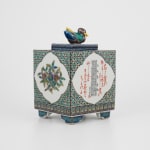Tamura Keisei 田村敬星 b. 1949
H12.0 x W7.5 x D7.5cm
With Signed Wood Box
Further images
-
(View a larger image of thumbnail 1
)

-
(View a larger image of thumbnail 2
)

-
(View a larger image of thumbnail 3
)

-
(View a larger image of thumbnail 4
)

-
(View a larger image of thumbnail 5
)

-
(View a larger image of thumbnail 6
)

-
(View a larger image of thumbnail 7
)

-
(View a larger image of thumbnail 8
)

-
(View a larger image of thumbnail 9
)

-
(View a larger image of thumbnail 10
)

-
(View a larger image of thumbnail 11
)

-
(View a larger image of thumbnail 12
)

-
(View a larger image of thumbnail 13
)

-
(View a larger image of thumbnail 14
)

The art of brush-writing micro-calligraphy on ceramics developed as a feature unique to Kutani wares. This art requires great skill and intense practice, and has been passed down for over a century from its founder, Seizan Oda 小田清山, to his descendants Kinsei Tamura 田村金星. First pioneered in the early Meiji Period of the late 19th century, early examples of this technique featured classical Chinese poems brushed inside of tea and sake cups. The art of micro-calligraphy grew out of the immense skill of painters during this period who created highly sophisticated and detailed compositions.
This exacting art was passed from Seizan to his son-in-law Kinsei Tamura, whose artistic talents became rapidly apparent. His inherent calligraphic skill together with his inventor’s spirit led him to create the first combination of micro-calligraphy and traditional Kutani paintings. Here, in the work of Kinsei Tamura’s grandson Keisei Tamura, we see the evolution of the art form over the decades. This piece is topped by a cunning lion and painted with a selection from 古今集 “Collection of Ancient and Modern Japanese Poetry.” This text is an early anthology of the Waka form of Japanese poetry, dating from the Heian period. This gorgeous incense burner marries tradition with innovation, meant to delight to both the senses and the intellect.
Tamura has met wide success with these calligraphic Kutani works. Born in 1949 in Kanazawa, he studied the family art of micro-calligraphy with his grandfather, Tamura Kinsei, beginning in 1969. Since then, his works have entered several public and private collections, including the Arthur M. Sackler Gallery, the Ishikawa Prefectural Museum of Art, the Nomi Kutani Ceramic Museum, and the Kanazawa Nakamura Memorial Museum. In 2005, he was designated an Intangible Cultural Property by the Ishikawa Prefecture for his innovative and integrative approach to ceramics and calligraphy.













